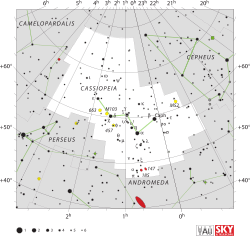Delta Cassiopeiae

| |
| Observation data Epoch J2000 Equinox J2000 | |
|---|---|
| Constellation | Cassiopeia |
| Right ascension | 01h 25m 48.95147s[1] |
| Declination | +60° 14′ 07.0225″[1] |
| Apparent magnitude (V) | 2.68[2] |
| Characteristics | |
| Spectral type | A5III-IVv[3] |
| U−B color index | +0.13[2] |
| B−V color index | +0.13[2] |
| Variable type | Eclipsing binary[4] |
| Astrometry | |
| Radial velocity (Rv) | −6.7[5] km/s |
| Proper motion (μ) | RA: 296.57[1] mas/yr Dec.: –49.22[1] mas/yr |
| Parallax (π) | 32.81 ± 0.14[1] mas |
| Distance | 99.4 ± 0.4 ly (30.5 ± 0.1 pc) |
| Details | |
| Mass | 2.5[6] M☉ |
| Radius | 3.90[7] R☉ |
| Luminosity | 63[6] L☉ |
| Temperature | 8,400[6] K |
| Rotational velocity (v sin i) | 123[8] km/s |
| Age | 6.0×108[7] years |
| Other designations | |
| Database references | |
| SIMBAD | data |
Delta Cassiopeiae (δ Cas, δ Cassiopeiae) is a star in the northern circumpolar constellation of Cassiopeia. It has the traditional names Ksora and Ruchbah,[9] derived from the Arabic word ركبة rukbah meaning "knee". It is not to be confused with Alpha Sagittarii, which also is called Ruchbah or Rukbat.
Naming
In Chinese, 閣道 (Gé Dào), meaning Flying Corridor, refers to an asterism consisting of δ Cassiopeiae, ι Cassiopeiae, ε Cassiopeiae, θ Cassiopeiae, ν Cassiopeiae and ο Cassiopeiae.[11] Consequently, δ Cassiopeiae itself is known as 閣道三 (Gé Dào sān, English: the Third Star of Flying Corridor.)[12]
The Proper Name Ksora for Delta Cassiopeiae appeared in a 1951 publication, Atlas Coeli (Skalnate Pleso Atlas of the Heavens) by Czech astronomer Antonín Bečvář. Professor Paul Kunitzch has been unable to find any clues as to the origin of the name.[13]
Properties
Delta Cassiopeiae is an eclipsing binary star system consisting of a pair of stars that orbit about each other over a period of 759 days.[4][14] The combined apparent visual magnitude of the two stars is 2.68, making it readily observable with the naked eye. However, this magnitude varies between +2.68 mag and +2.74 as the stars pass in front of each other.[15] Based on parallax measurements, this system is about 99.4 light-years (30.5 parsecs) from the Earth.[1]
The primary member of the system has a stellar classification of A5III-IVv, with the luminosity class of IV indicating that it has exhausted the hydrogen at its core and has begun to evolve through the subgiant phase into a giant star.[3] It has expanded to about 3.9 times the Sun's radius.[7] The lower case 'v' in the stellar class indicates that the spectrum shows signs of variation. The system has an estimated age of 600 million years.[7]
An excess infrared emission has been observed at a wavelength of 60 μm, which suggests the presence of a circumstellar debris disk. This emission can be characterized by heat radiated from dust at a temperature of 85 K, which corresponds to an orbital radius of 88 Astronomical Units, or 88 times the distance of the Earth from the Sun.[7] For comparison, the region of the remote Kuiper belt in the Solar System extends from 30–50 AU.
References
- ↑ 1.0 1.1 1.2 1.3 1.4 1.5 van Leeuwen, Floor (November 2007), "Validation of the new Hipparcos reduction", Astronomy and Astrophysics 474 (2): 653–664, arXiv:0708.1752v1, Bibcode:2007A&A...474..653V, doi:10.1051/0004-6361:20078357 Note: see VizieR catalogue I/311.
- ↑ 2.0 2.1 2.2 Johnson, H. L. et al. (1966), "UBVRIJKL photometry of the bright stars", Communications of the Lunar and Planetary Laboratory 4 (99), Bibcode:1966CoLPL...4...99J
- ↑ 3.0 3.1 3.2 "V* del Cas -- Variable Star", SIMBAD (Centre de Données astronomiques de Strasbourg), retrieved 2010-02-21
- ↑ 4.0 4.1 Malkov, O. Yu. et al. (February 2006), "A catalogue of eclipsing variables", Astronomy and Astrophysics 446 (2): 785–789, Bibcode:2006A&A...446..785M, doi:10.1051/0004-6361:20053137
- ↑ Wilson, Ralph Elmer (1953), General catalogue of stellar radial velocities, Carnegie Institution of Washington, Bibcode:1953QB901.W495.....
- ↑ 6.0 6.1 6.2 Kaler, James B., RUCHBAH (Delta Cassiopeiae), University of Illinois, retrieved 2011-12-09
- ↑ 7.0 7.1 7.2 7.3 7.4 Rhee, Joseph H. et al. (May 2007), "Characterization of Dusty Debris Disks: The IRAS and Hipparcos Catalogs", The Astrophysical Journal 660 (2): 1556–1571, arXiv:astro-ph/0609555, Bibcode:2007ApJ...660.1556R, doi:10.1086/509912
- ↑ Royer, F.; Zorec, J.; Gómez, A. E. (February 2007), "Rotational velocities of A-type stars. III. Velocity distributions", Astronomy and Astrophysics 463 (2): 671–682, arXiv:astro-ph/0610785, Bibcode:2007A&A...463..671R, doi:10.1051/0004-6361:20065224
- ↑ 9.0 9.1 Bakich, Michael E. (1995), The Cambridge guide to the constellations, Cambridge University Press, p. 170, ISBN 0-521-44921-9
- ↑ Allen, Richard Hinckley (1899), Star-names and their meanings, G.E. Stechert, p. 148
- ↑ (Chinese) 中國星座神話, written by 陳久金. Published by 台灣書房出版有限公司, 2005, ISBN 978-986-7332-25-7.
- ↑ (Chinese) 香港太空館 - 研究資源 - 亮星中英對照表, Hong Kong Space Museum. Accessed on line November 23, 2010.
- ↑ Kunitzch, Paul; Smart, Tim (2006) [1986]. A Dictionary of Modern Star Names: A Short Guide to 254 Star Names and Their Derivations. Cambridge, Massachusetts: Sky Publishing Corporation. p. 62. ISBN 978-1-931559-44-7.
- ↑ Burnham, Robert (1978), Burnham's celestial handbook: an observer's guide to the Universe beyond the solar system, Dover books on astronomy and astrophysics 1 (2 ed.), Courier Dover Publications, p. 492, ISBN 0-486-23567-X
- ↑ Kukarkin, B. V. et al. (1971), "The third edition containing information on 20437 variable stars discovered and designated till 1968", General Catalogue of Variable Stars (3rd ed.), Bibcode:1971GCVS3.C......0K
| ||||||||||||||||||||||||||||||||||||||||||||||||||||||||||||||||||||||||||